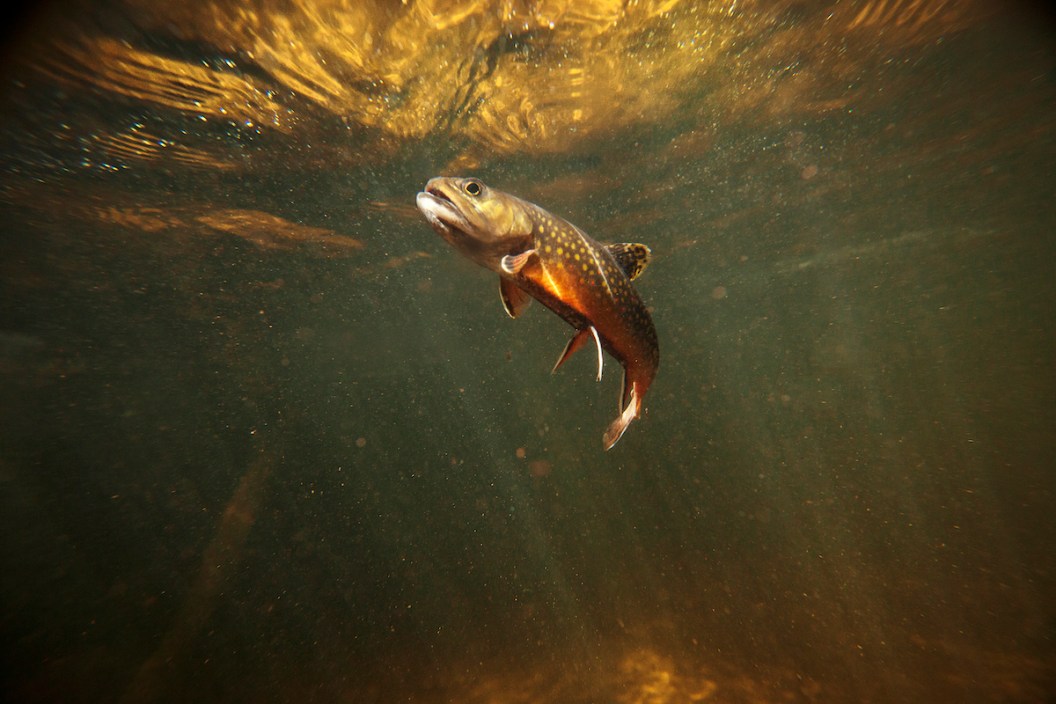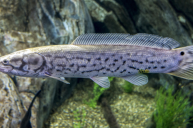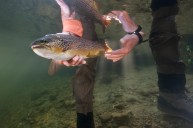Smooth, speckled, and sometimes elusive, there are variations of trout swimming through waterways all across the country, from the Pacific Northwest's far reaches, down through the Rocky mountains, across to the steamy South, and all the places in between.
Trout are a type of freshwater fish that thrive in cold and clear bodies of water such as lakes, rivers, and streams. Some trout do spend a portion of life in saltwater and travel to freshwater streams to spawn. Trout have long oval bodies and a long dorsal fin. Trout belong to the subfamily Salmonidae, which also includes many species of salmon and char.
There are many different variations of trout, and we have put together a guide for every species of trout that's found in the United States.
Brown Trout
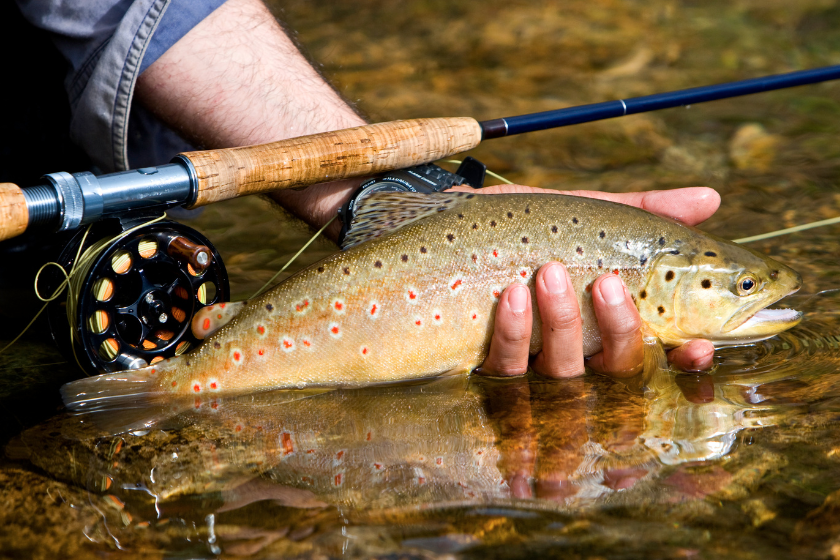
MarceloDufflocqw via Getty Images
Brown trout (Salmo trutta) are a non-native species with European origins. They were first introduced to North America in the 1860s and are widespread across much of the United States.
A few names, including brown trout, brownies, and German brown trout, refer to brown trout. There are two variations of brown trout: The freshwater variation and Salmo trutta morpha trutta, also known as the "sea trout." These trout are usually, as the name implies, brown in coloration. But white and silver specimens are not uncommon. The body features spots that give the fish its iconic appearance. The brown is one beautiful fish.
Brown trout feed mainly on aquatic insects and typically weigh around ten pounds but can occasionally get much larger. The biggest brown trout ever caught weighted 44 pounds 5 ounce and was 38.58 inches long with a 34 inch girth. This world record was caught on the Ohau Canal in Twizel, New Zealand by Seumas Petrie in 2020.
You can catch brown trout on a variety of fly patterns. The non-fly fishing anglers know brown trout respond well to inline spinnerbaits and small spoons.
Rainbow Trout (or Steelhead)
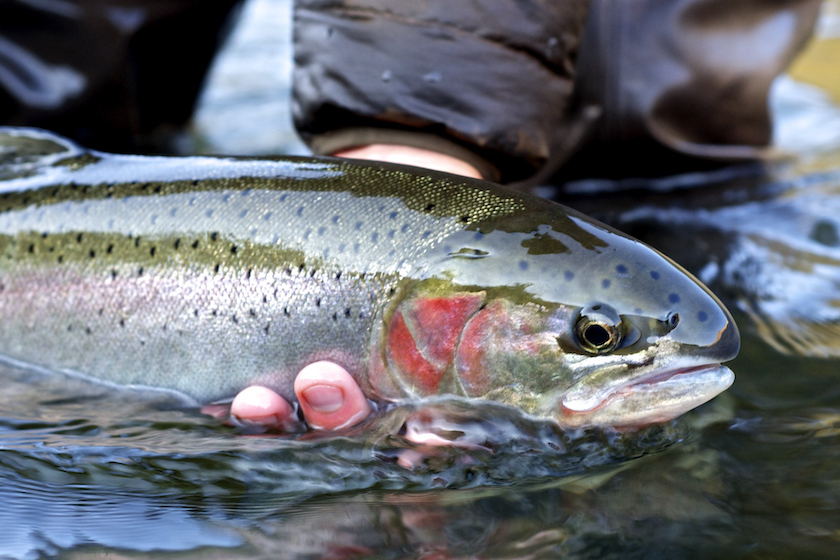
DecHogan via Getty Images
Perhaps the most easily recognizable species of trout is the rainbow trout. A prevalent species, this one can cause some confusion with novice anglers because there are two different variants with different names. The regular rainbow trout (Oncorhynchus mykiss) usually is the smaller of the two. You'll find them in mountain streams across the U.S. and as far North as Alaska. They are only genuinely native to the Pacific Northwest states of California, Washington, and Oregon. Still, they've been successfully introduced across the country.
The other variation is the steelhead trout. The steelhead is like salmon. They spend much of their life in the ocean before migrating back to freshwater streams. Remember, you've got a rainbow if you have a fish that never leaves freshwater. However, you'll still sometimes hear the steelhead name used for fish that never see the ocean.
READ MORE: 6 Bucket List Steelhead Fishing Destinations
The rainbow trout is a beautiful fish with widely varying coloration. Most specimens are going to display black spots over much of their body. The primary color is usually green or greenish brown, with hints of pink and red. Look into subspecies, such as redband trout. You'll see even more variation, with some fish having heavy black bands. One treasured color subspecies mutation is golden trout. Steelhead appears similar but will sometimes have more bronze or silvery coloration.
Both species are popular for fly anglers, but any fisherman can catch them on live bait and artificial lures. Sometimes you can even catch them ice fishing if you're in the right place. The IGFA recognizes a 48-pound beast caught in Canada as the all-tackle world record.
Cutthroat Trout
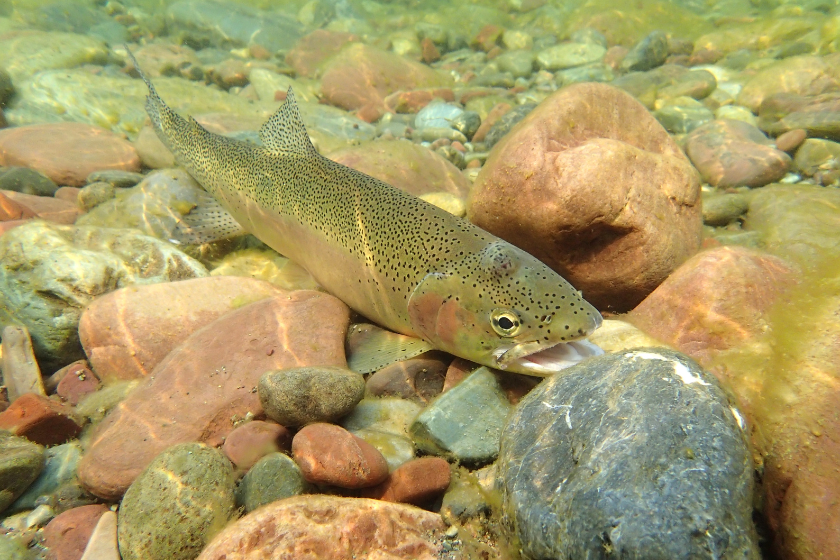
mlharing via Getty Images
The native cutthroat trout (Oncorhynchus clarkii) gets its name from the distinctive red streak under and behind the jawline. There is a lot of variation among cutthroats in coloration and size. The color of the body ranges from cadmium blue and silvery (sea-run) to olive-green or yellowish green. There may or may not be red on the sides of the head, the front part of the body, and the belly.
Cutthroats are a favorite of dry fly fishermen. However, anyone can readily catch them on a variety of artificial lures.
They are found mainly in Western states like Colorado, Montana, Utah, Wyoming, Idaho, and New Mexico. Part of their native range includes parts of Northern California and regions of Washington and Oregon.
There are several subspecies of cutthroat living all over the U.S., including the Yellowstone cutthroat, the coastal cutthroat, and the legendary Lahontan cutthroat, listed as federally threatened.
The Lahontan cutthroat is the largest of all subspecies. It is responsible for all the biggest fish in the IGFA record book. Pyramid Lake, Nevada, has produced all-tackle records for both weight and length.
The weight record, a 41-pounder, was caught on Pyramid in 1925. A lucky angler set the length record in November 2018 with an 33inch fish. That lake is also home to numerous line class and tippet world records.
Dolly Varden Trout
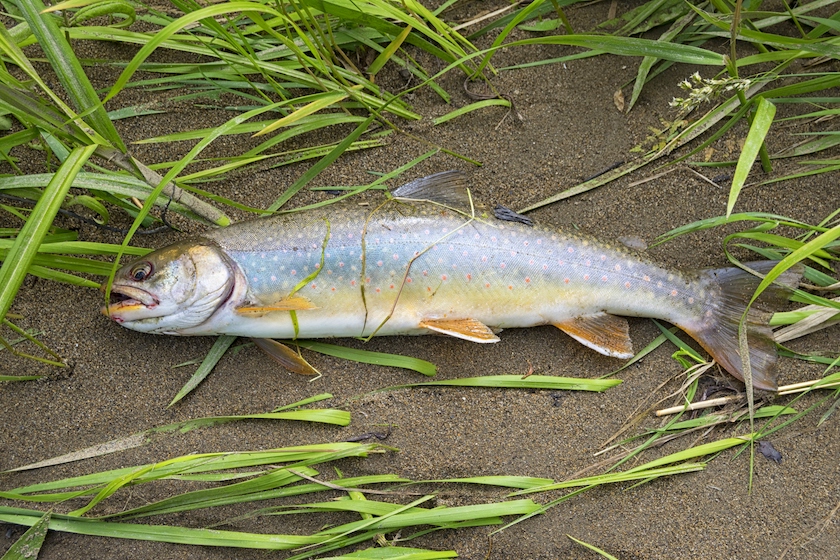
bksrus via Getty Images
Is it a trout? Is it a char? Technically this is a char, a member of the salmon family. Trout are also part of this extended family. We should mention that "trout" describes many members of both trout and char. But given its long association with the trout name, we're including char in this guide. (There will be more examples of this later).
The Dolly Varden is a little more obscure than the other species discussed thus far. That's because Salvelinus malma has a much more limited native range. In the U.S., you can only find Dolly Varden trout in the extreme northwestern part of Washington and parts of Alaska.
Named after a feisty fictional character known to wear brightly colored outfits from a Charles Dickens novel, coloring on a Dolly Varden trout can vary wildly based on location. Dolly Vardens have light-colored spots that can be pink, red, white, or even yellow speckled over a light-colored brown, green, or grey-blue body. This species is anadromous most of the time, but it can survive in a landlocked setting too.
The Dolly Varden prefers the cold waters of mountain lakes and streams, where they feed on various aquatic species. They also eat eggs of other species, leading to Dolly Varden's undesirable reputation. Usually, it's tough to find a Dolly Varden over 10 pounds. IGFA's all-tackle world record is a 20-pound, 14-ounce fish caught by Raz Reid on the Wulik River in Alaska in 2001.
Bull Trout
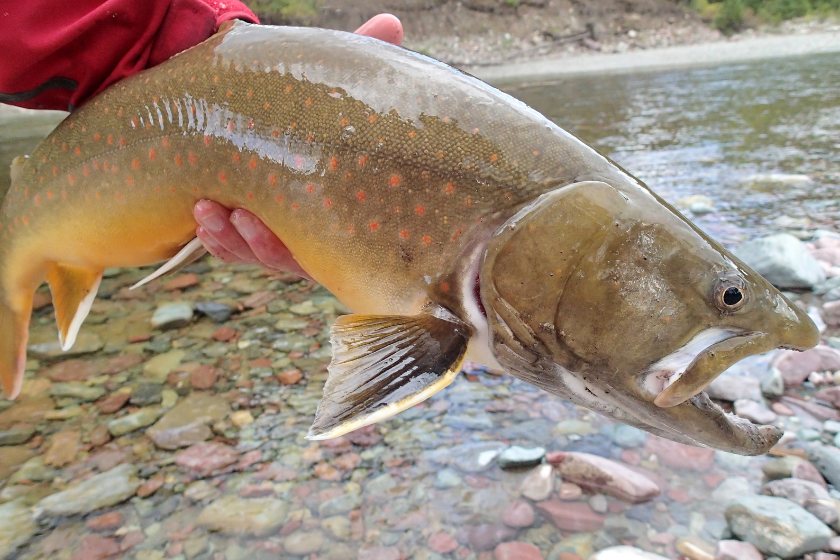
mlharing via Getty Images
?Salvelinus confluentus is another char. It so closely resembles the Dolly Varden it took until 1980 before scientists finally classified the bull trout as a separate species. Once again, this fish has a limited range.
In the U.S., you'll mostly find them in Washington and Oregon. There are populations in Idaho and Montana too. Like the Dolly Varden, this species gained a bad and undeserved reputation for eating other, more desirable species.
Bull trout can spawn with non-native brook trout. They also require waters that are cold and clear to spawn. Now the species is considered threatened, and there are often heavy fines for not releasing one.
So, how do you tell a bull trout from a char? Remember that, usually, true trout have dark spots (brown to black) on a light body. Char has light spots (white or yellow to red) on a dark body.
This video details more of the plight of the bull trout and what they're currently doing to try and save them. The good news is that more habitat is being protected for this fish to return. You can't keep them, so the all-tackle world record has stood for a while now. It's a 32-pounder caught in Lake Pend Oreille in Idaho in 1949.
Brook Trout

invs572517 via Getty Images
Since we just mentioned the brook trout as a threat to the bull trout, we should talk about Salvelinus fontinalis too.
Brook trout are native to the Northeastern United States and the Great Lakes Region. Humans later introduced them all over the American west and even Europe. These days, they are considered invasive in areas they are not native.
As we already mentioned, their ability to spawn with bull trout has resulted in hybrids harming bull populations.
Brook trout are hardy and live comfortably in lakes, streams, and rivers, although they prefer clear, colder waters. Brook trout are considered an "indicator species," meaning the overall health of a sustaining population within a body of water usually reflects the health of that local ecosystem. A suffering or declining brook trout population indicates something is going on environmentally.
This fish is generally darker in color than other trout species. It's usually brown or green, and the belly is often a distinctive red or orange. The body features light-colored dots that are generally white or yellow in coloration. This fish can also reproduce with lake trout and brown trout. The result of a lake trout/brook trout hybrid is a splake, and a brown trout/brook hybrid is a tiger trout (More on those later).
You can catch them with various fishing techniques, from casting with inline spinners and spoons to live bait. Of course, fly fishing is the most popular way to catch them. The world record for a brook trout is a 14-pound, 8-ounce fish caught on the Nipigon River in Ontario in 1915. The crazy thing about that fish is that someone didn't weigh it until five days later. Experts think it may have weighed as much as 20 pounds while alive! The error led to a debate about whether the fish Dr. J.W. Cook caught was a brook trout. Some think it could have been a brown.
Unfortunately, Cook lost the original mount in a fire, so we can't do a genetic test to find out for sure. As a result, many people think this record is unbreakable.
Tiger Trout
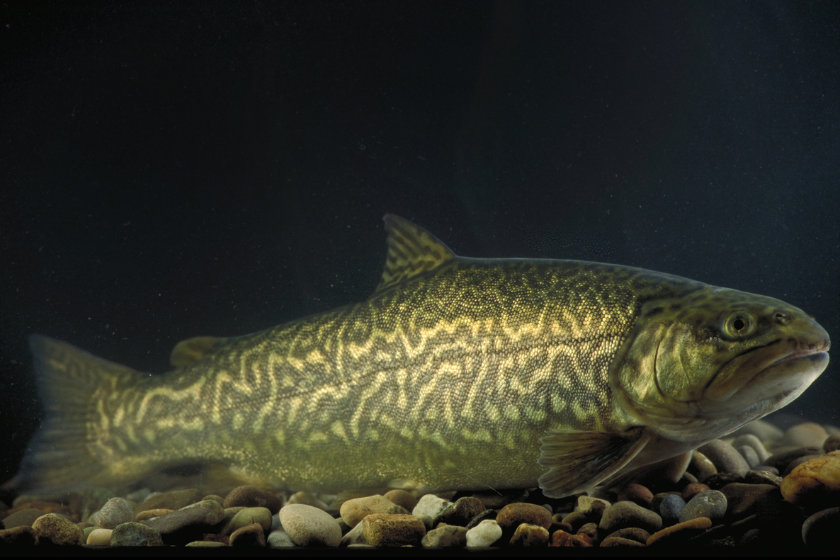
U.S. Department of Agriculture, Public domain, via Wikimedia Commons
The tiger trout is a sterile hybrid of brown trout and brook trout. Tigers are colorful with red bellies and brown, grey, or silver bodies. Distinctive bar and stripe patterns overlay the tiger trout's body-each pattern varies from fish to fish.
You might think biologists and wildlife agencies would loathe a sterile hybrid like this. Still, they're a popular fish to rear in fish hatcheries.
Anglers love tiger trout because they're aggressive and fun to catch. You can find tigers almost anywhere brook trout and lake trout swim. But some of the biggest fish have been found in the Great Lakes region. A woman caught the world record tiger trout on Loon Lake in Washington. The Washington Department of Fish and Wildlife verified the catch to weigh 27.42-pounds, with a 35.5-inch length and 28.125-inch girth.
Splake Trout
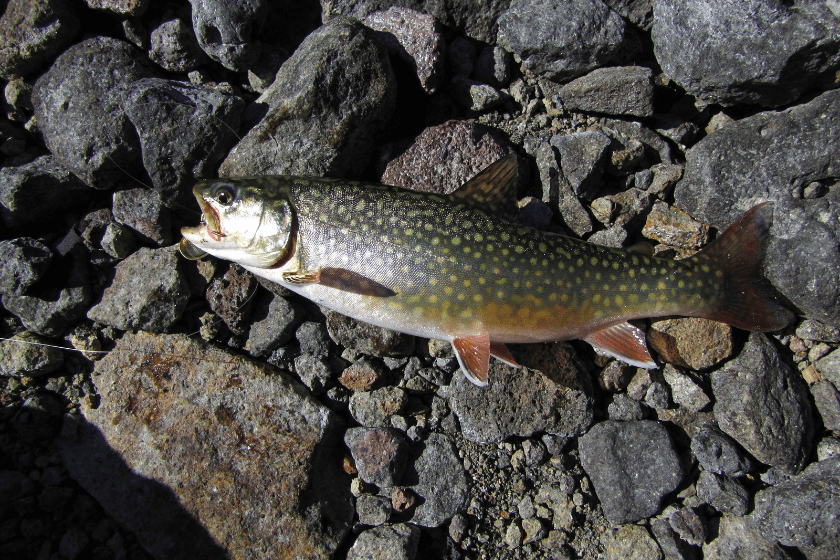
Bryant Olsen via Flickr
The splake, another hybrid, results from the pairing of a brook trout and lake trout. While splakes do occur naturally in the wild, this fish is an artificial creation for the most part.
Fish hatcheries have been producing splake for decades now. They are aggressive, fast-growing, and catchable through various fishing methods. Splakes are a favorite target for ice fishermen on many northern lakes.
Splakes can be found across the United States and in the Great Lakes. It does retain some characteristics of both parent fish, making it a unique species to target while fishing. Splakes are generally dark with light spots. The coloration varies from green to brown, and the belly may be white or orange.
The IGFA all-tackle world record is a 20-pound, 11-ounce fish pulled from Ontario's Georgian Bay in 1987.
Lake Trout
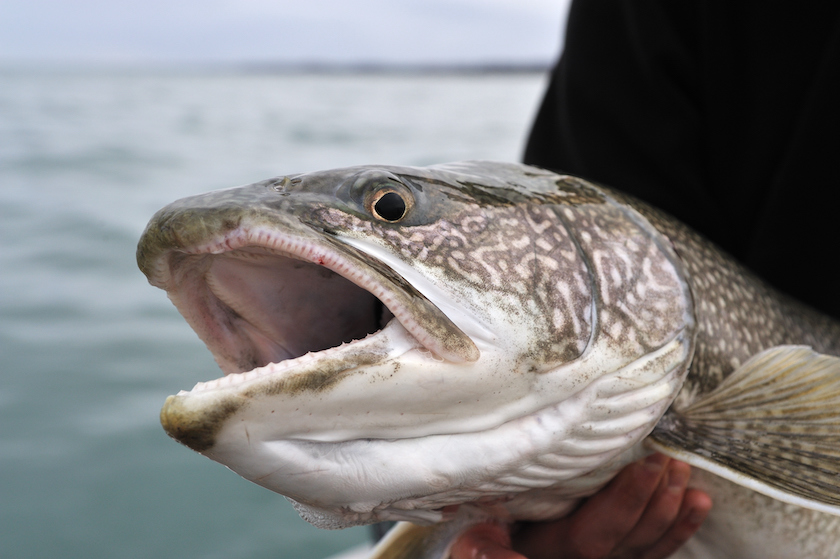
glxedwards via Getty Images
Of course, we couldn't leave this prized game fish off the list, even though this is technically a char. Lake trout are usually associated with the northeast part of the U.S., where populations thrive from Maine down to New York. They are also abundant in the Great Lakes Region but are harder to find in the western United States.
Anglers prize this fish for the fight, size, and because they're great for eating. Like so many trout (and char) on this list, coloration varies depending on where you catch them. Many fish are a light grey or olive color. Others may appear silver or almost white. The speckled pattern over most of the body gives this fish an iconic look.
Lake trout have an exceptionally long lifespan. The Wisconsin Department of Resources captured and released one estimated to be 46 years old.
Lake trout often grow huge. The all-tackle world record is a 72-pound monster caught in Canada's Northwest Territories in 1995. But we know these fish get much bigger than that.
Three years ago, a Native American tribe in the Northwest Territories gill-netted an 83-pounder. And rumors persist that 100-plus pound lake trout have been caught by commercial fishermen before. If you're looking for a species that probably hasn't maxed out the world record yet, a lake trout is a good one to fish.
Golden Trout
Golden trout are a unique species of trout because they only inhabit freshwater lakes and rivers that are at high altitudes ranging between 9,000 and 12,000 feet above sea level. They swim in schools, unlike most other trout species. This species is very meek and not aggressive like many other trout species.
The name comes from their golden-yellow bodies adorned with orange-red stripes along the body and dark spots around the tail and dorsal fin. Golden trout usually grow to be about 6 to 12 inches in length.
Golden trout primarily feed on surface-dwelling insects and larvae, and because insects do not survive winters, golden trout have a primary feeding season that lasts from May to September.
Gila Trout
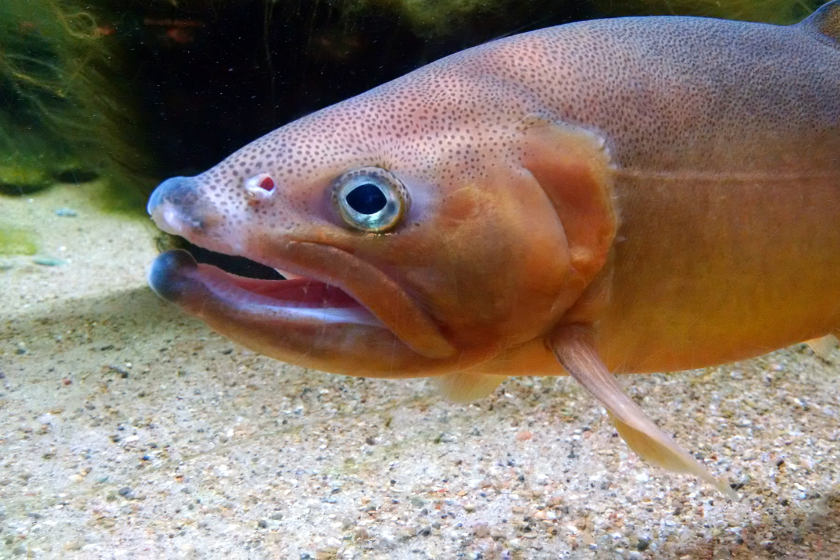
Crissy1982 via Getty Images
Oncorhynchus gilae is a scarce species of trout. Gila trout classifies as endangered, and in many cases, the U.S. Fish and Wildlife Service has been quite reluctant even to let people fish for them. This fish is native to the Gila River, which runs through New Mexico and Arizona, so it has a minimal range.
This trout's body is golden colored with black dots. It eats aquatic insects, making it a legendary target of fly anglers where they can gain permission to target them.
This trout does not grow very large. The world record is just 3 pounds, 7 ounces, and it was caught from the Frye Mesa Reservoir in Arizona in 2011.
Apache Trout
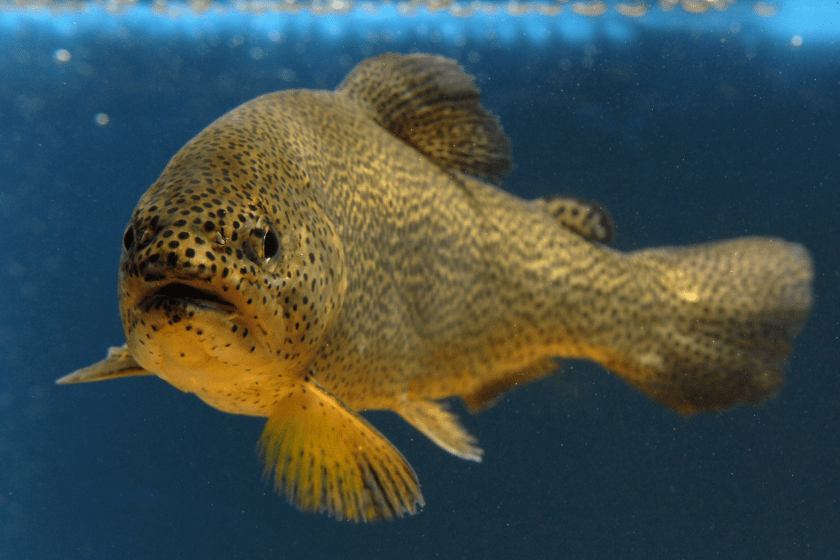
Amygleich, CC BY-SA 4.0, via Wikimedia Commons
This fish is in the same family as the Gila trout and is also found primarily in Arizona. It's a cold-water fish that is usually a golden color. It also sometimes has a distinctive black mark above its eyes.
The Apache trout's ill-advised spawning habits leave them critically endangered. This species can and does spawn with cutthroat and rainbow trout, jeopardizing each species' genetic diversity. Also, the increased rate of American forest fires threatens Apache trout populations.
Biologists have been working for years to restock this fish from hatchery stocks. Because of this fish's endangered status, you might have a tough time finding a place to target them. Many streams with them are closed entirely, and others may levy heavy fines if you kill one.
Like the Gila trout, this species doesn't grow to especially massive sizes. The IGFA world record is just 5 pounds, 3 ounces. John Baldwin caught that fish in the White Mountain Apache Reservoir in 1991.
